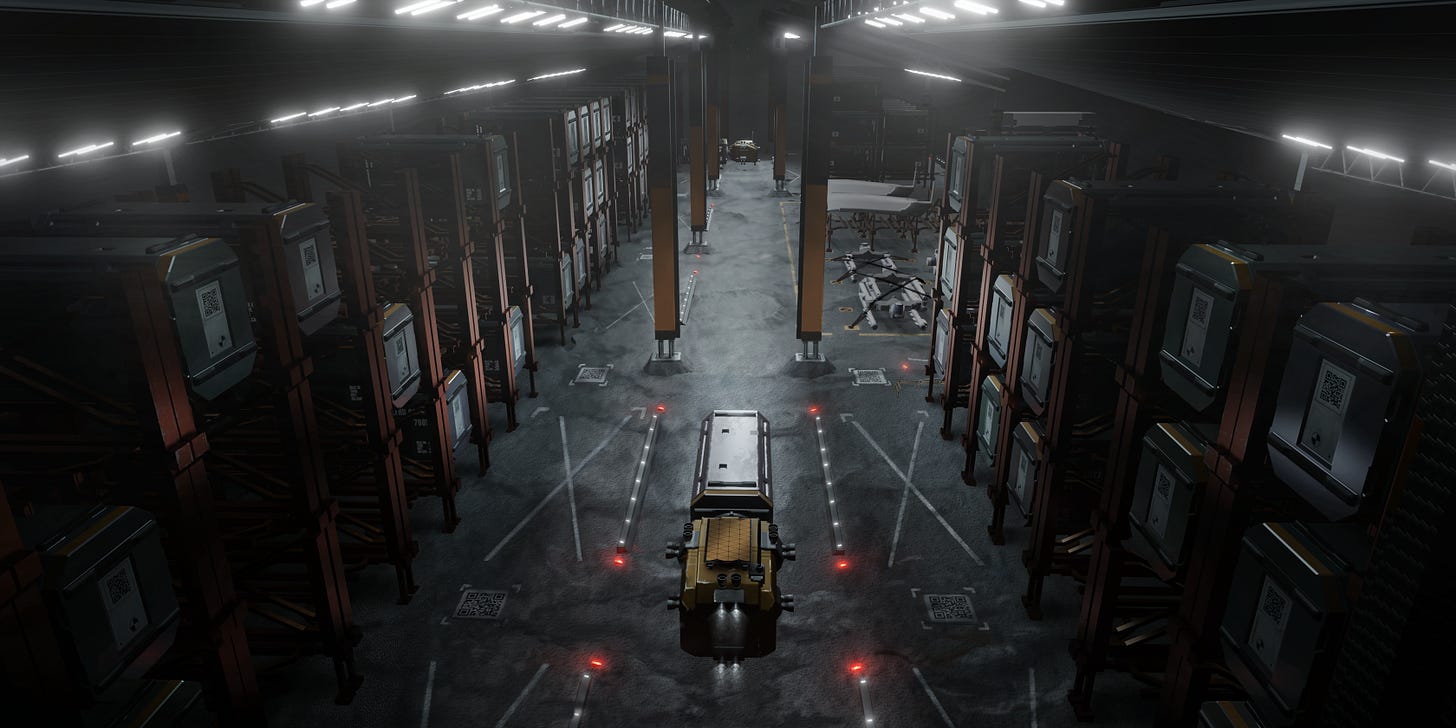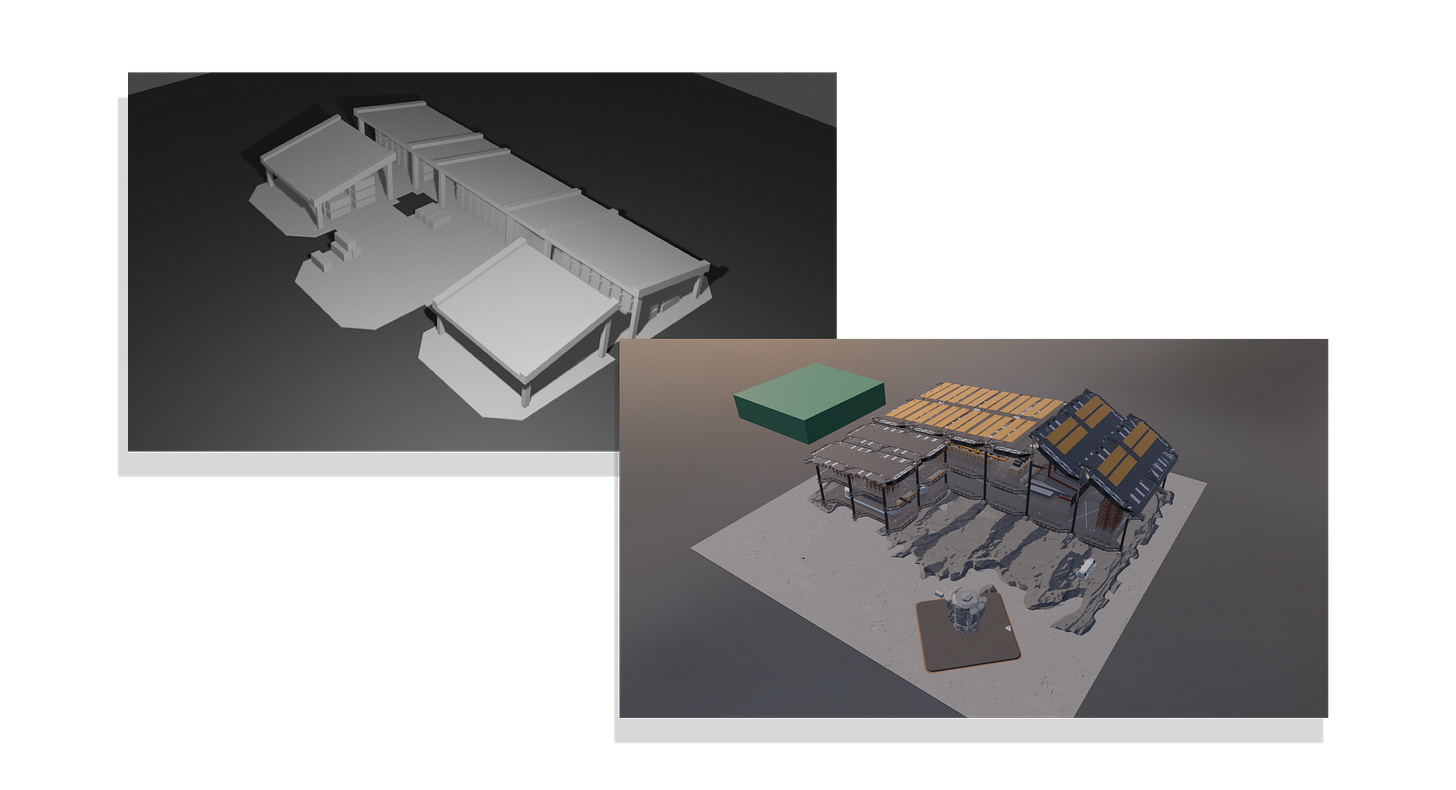The Warehouses within Adalia will allow players to organize and store resources, items, materials, and components. Additionally they serve as the point in which materials will flow to and from while allocating your inventory for building infrastructure, listing to specific marketplaces, and loading items into ships.
Design Brief
The Warehouse is a simple building, with no built-in automation or moving parts. It has two main storage areas: the container racks and the bulky objects lot.
The container racks are designed to hold standard Adalian shipping containers such that they can be accessed by hoppers. The container racks have a Whipple shielding “roof” to decrease the odds of micrometeorite impacts.
The bulky objects lot, by contrast, is just an expanse of shotcrete with built-in tie-down points. It is designed to store large objects that do not fit in storage containers, such as ship parts. There is no Whipple shielding roof, so that hoppers, sometimes several working together, can maneuver the large ship parts into and out of storage.
The entire building and every stored container/part are plastered with QR codes, which help the hoppers’ computer vision orient them within the building and locate items in inventory.
Features
Whipple shielding ‘roof’: A stack of several layered steel panels, with significant spacing between them, held together by lightweight trusses. When a micrometeorite hits the outer layer at orbital velocities, it will go through it like butter, but will be vaporized in the process, leading to an expanding ball of plasma and fragments of the outer layer still traveling inwards at dangerous velocities. The spacing gives time for the plasma and fragments to expand, so that the inner layers can catch those fragments in a spread-out pattern, rather than concentrated at a point, which could easily go through the inner layer as well if it were too close to the outer layer.
Large Ship Component Storage: The uncovered section of the warehouse provides an area that is easy for both he workers and hoppers to organize and move larger ship components, which would be difficult to otherwise move if covered.
Tie down points: Embedded in the shotcrete of the bulky objects lot are steel rings, which can be used to tie the bulky ship parts down to the surface. This is actually much more important than on Earth, because large parts, while massive, often have a large surface area, while weighing very little in the asteroid’s microgravity. An accidental bump from a hopper, or even just its thruster plumes, could send a part tumbling out of control to damage the building or other items. Firmly connecting parts to the surface prevents this.
Shotcrete base: As with all permanent structures on asteroids, the Adalians place a thin layer of shotcrete (sprayable concrete) across the asteroid’s surface in the shape of the Warehouse’s footprint. This provides a stable surface to attach the building to, and also prevents dust and debris from being constantly dislodged and sent flying by construction and hopper thruster plumes.
Hoppers: Small automated Adalian tugboat ships that are responsible for moving most goods around on asteroid surfaces. Able to attach to a single shipping container, or to a bulky part, or to a Habitation Module when crews are traveling point-to-point on asteroids. Have small cold-gas thrusters for navigation close to the surface, and a hydrolox hot-fire engine for burns onto ballistic trajectories across the asteroid’s surface. Not strictly part of the Warehouse, but rather shared by all residents and buildings on an asteroid.
Footing Attachment Points: These points are where the metal structure of the warehouse is anchored into the shotcrete and ground. This give the structure it’s stability.
QR Code: This is a simple but effective way for both the Adalians and the Hoppers to be able to easily identify the warehouse and the contents. This increases efficiency and the ability for automation, and is universally utilized by the Adalians.
Interior space: The container racks are spaced to create open corridors within the Warehouse, again to give hoppers room to maneuver within the building. Note that hopper cold gas thrusters firing within an enclosed building could damage things, which along with hopper access and mass reduction is another reason for the Warehouse having no walls.
Container storage racks: A lightweight three-dimensional grid of steel beams, sized to fit standard Adalian storage containers (which are significantly larger than the ones old Earth had). There is an intentional gap between the uneven shotcrete ground and the first container level, to give hoppers vertical room to maneuver.










